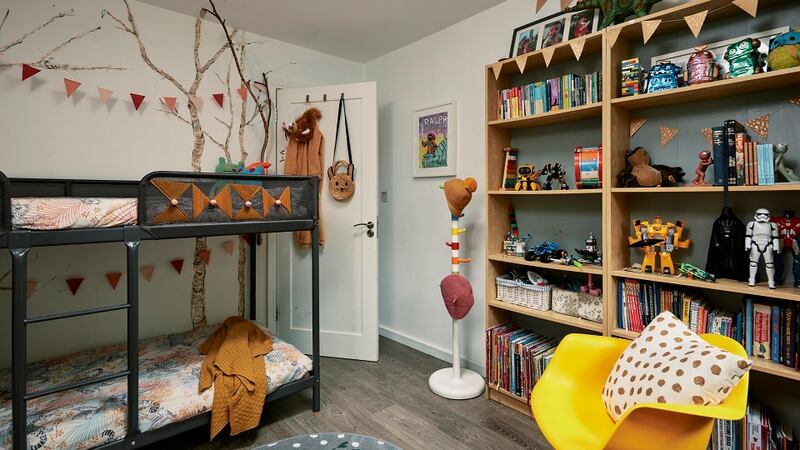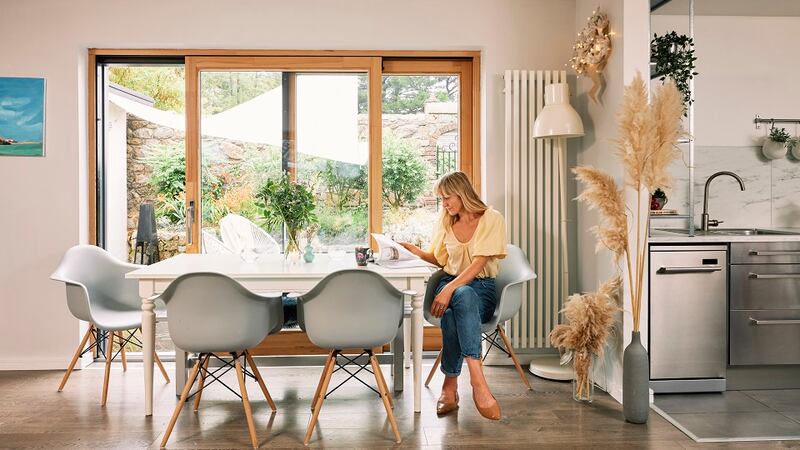In part six of our Switch it Up series, we explore the gentle approach that artist Isobel Henihan has taken to a ‘living renovation’ in her home. Nestled in an idyllic setting near the sea in South County Dublin, Isobel lives here with husband Ben and their three children.
Moving into a new house is one of the most exciting milestones there is, and it’s not unusual to get caught up in the enthusiasm, going for the ‘what suits right now’ property without considering how the house may need to work differently down the line.
As children come along, space is at a premium, but there are ways that you can make your spaces grow and evolve with you, and you don’t have to spend too much, either.
When we first moved in our understanding of what we needed was different to how it has transpired with three kids
Isobel knows this first hand. Her airy, contemporary bungalow is a perfect example of a property that has been adapted and evolves constantly via mini renovation projects to meet her growing family’s needs. She and Ben constantly update the space to make it work for them.
“When we first moved in our understanding of what we needed in a house was different to how it has transpired with three kids,” she says, “but the property has evolved quite well with us and the needs of a growing family.”
While the structural layout has remained the same since it was built in 2013, the use of rooms, as well as much of the decoration, design and zoning of spaces, has changed over the years. They have done much of the work themselves.
“We have three bedrooms, one is quite small, and that started out as our eldest’s. We also had a guestroom and a master bedroom, but when we had our second child, bunk beds went into the guestroom and the other room became a play room. As the eldest got older and needed space, we made the playroom into a bedroom again. So that’s ever changing,” she says.

Having opted for a striking industrial-style kitchen, complete with built-in stainless steel cabinets and an integrated fridge, Isobel felt the kitchen was not performing adequately for a growing family – “we needed a bigger fridge for all the litres of milk,” she laughs.
One half of the kitchen was redesigned with more storage and practicality in mind. “We got new units in Ikea to house an American style fridge. We went for pale grey to form a nice contrast,” she says, adding, “my husband is very handy so he did a lot of the carpentry.” Recently, the couple has updated the kitchen again with new on-trend marble-effect worktops and splashbacks – an edit that gives a new look and feel and didn’t cost the earth.
Isobel was eager for the kitchen to have an island, but didn't want to commit to one layout for the space. “We got an island and attached end panels on to either side to give it a more solid feel, and we move it whenever we need a change of scene,” she says. It means the floor area of the central open-plan space in the house is adaptable – important for socialising, kids playing and for the fact she uses this area as her artist’s studio too.

If she’s not painting on canvas, she’s “constantly painting walls” or changing the colours in each room to keep the space dynamic and fresh.
“Our main living area is open plan, including the kitchen, dining and living area. I wanted to zone that and make the living area feel like a cosy entity in its own right. I did that with colour – I mix my own paints to get the exact right shade. I also introduced lots of planting to the area to give that feeling of calm and relaxation,” she says.
As with many home owners, the couple didn’t pay much attention to small details like switches or sockets, but as time passed, these seemingly inconsequential features became more noticeable. A simple YouTube tutorial on how to install light switches and some inexpensive brushed steel sockets totally changed the look in each room.

“There are lots of renovations that can be done incrementally when doing up the home and it’s not a big outlay. I love going on classified ads – you can find fantastic pieces on there. I hate waste and have a great respect for all that those sites have to offer. If you have a piece of furniture you feel is standing in the way of you achieving the look you want, sell it online and buy something else,” Isobel says.
A recent example is a bed frame bought for €30, which she painted and the finished piece has helped transform the master bedroom. So too has some abstract panelling, designed along with Ben, but, “he did all the hard work, woodwork is not my forte,” she laughs.

Clever use of space and storage is evident throughout the house; the sofa is modular and can be reconfigured, and the inside of a coffee table doubles up as book storage. “I also didn’t like the look of the kid’s toy boxes, so I cut a curtain in half, sewed a hem on to it and put it around them,” she says.

A mural by Isobel adorns the younger children’s bedroom wall.
“Originally it was a starburst, which was a lovely focus piece but that was too stimulating for bedtime, so I painted a birch mural onto the wall and placed some cut off birch branches on to their bed, creating a much calmer woodland feel.” This is focal point that any homeowner could recreate easily, she says.
“With this property we have figured out a way to make the house work for us, as it stands. It’s such a special area and we feel so lucky to be close to the sea,” Isobel smiles. “And with a lovely community of friends and schools nearby, we are very happy here.”
About Switch it Up
Switch it Up is a new 12-part series for those who might be considering switching mortgage provider to make savings on their monthly repayments. It is a follow-up to the award-winning Story of Home series, which explored the idea of home through the eyes of creative people who found their dream place to live.
Now, Switch it Up, which like Story of Home is supported by Ulster Bank, looks at helpful information on home improvements as well as renovators' home tours. Plus, we've got helpful answers to your mortgage switching queries: from the incentives to how long it will take (not long!) and what's involved in making a mortgage switch, read our Everything you need to know about switching your mortgage guide at irishtimes.com/switchitup.
Perhaps now more than ever, we want our homes to suit the way we live and work, and being able to explore the potential in our homes offers us flexibility. This series is designed to unlock the ways in which we might Switch it Up in our homes as our wants and needs change.
Switching your mortgage could free up funds to help you make these changes. “At Ulster Bank, we want to be a part of the journey you take in making your home the best it can be,” says Sean Kellaghan, mobile mortgage manager at Ulster Bank.
“We want to make the mortgage switching process as simple and as hassle free as you do,” he adds. Kellaghan understands the stress that can come with making a switch, and he offers reassurance.
“We are here to help you, and the process is a lot shorter and a lot more straightforward than you might think. Get in touch today and we can talk you through the options and process.”
[ ulsterbank.ieOpens in new window ]
Ulster Bank Ireland DAC is regulated by the Central Bank of Ireland










